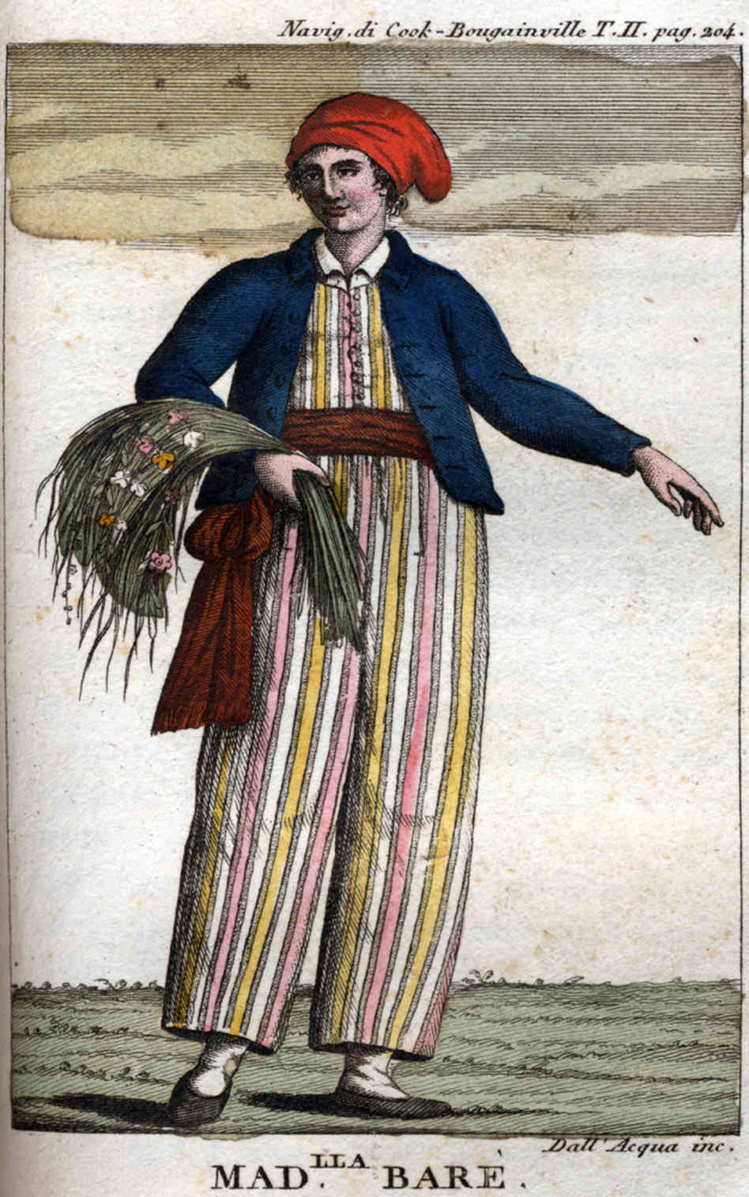
Portrait of Jeanne Baret by Cristoforo Dall’Acqua
Six of Washington University’s plant-science biologists are female. They travel the world easily. Not one of them, to my knowledge, has had to shear off her hair and bind her breasts to do so.
That was the trick used by Jeanne Baret, a self-taught herbalist who became the first woman to circumnavigate the globe.
Baret’s father was a day laborer in a small French village where, in the mid-1700s, the average life expectancy was twenty-six years. Yet at twenty-six, Baret was embarking on a dramatic voyage with her lover, botanist Philibert Commerson.
The year was 1766. Disguised as Commerson’s male secretary, she joined explorer Louis Antoine de Bougainville’s round-the-world expedition. She had 330 men to fool. In The Discovery of Jeanne Baret: A Story of Science, the High Seas, and the First Woman to Circumnavigate the Globe, Glynis Ridley contradicts the accepted version, in which Bougainville was shocked—shocked!—to learn of her identity a year later, when they landed in Tahiti and the Tahitian men instinctively knew she was a woman. Please.
The truth is, Bougainville would have gotten in trouble for ignoring French law, had he admitted what Ridley’s original research suggests: that the crew tumbled to Baret’s identity fairly soon. There was a little awkwardness about “Jean” never stripping off “his” shirt in the hot sun or peeing through holes in “the heads,” part of the ship’s deck that jutted out over the ocean. The final giveaway? Baret’s refusal to join in with the ritual when the crew crossed the equator and stripped naked, oiling their bodies and barking and howling like animals.
Often seasick, she shut herself up in Commerson’s stuffy cabin while he threw up on deck and breathed the salty fresh air. How lonely she must have been, muscles aching from extra labor she did without wincing, tense with hypervigilance, exhausted. It may have been a relief to be outed—but then she had to hide a loaded pistol to protect herself.
Nonetheless, she gathered berries to relieve the sailors’ veneral disease, and she helped them ward off scurvy. She also nursed Commerson through several health crises. When he was ill, she went ashore alone to collect the specimens, hoisting a leather satchel (glass vials, bug boxes, mesh net, telescope, magnifying glass, knives, spade, compass) on one shoulder and tucking a wooden field press under the other arm.
All told, she and Commerson collected more than 6,000 specimens. One of the plants Baret discovered is bougainvillea, politely named for the commander. Commerson did name baretia for Jeanne, but the name was soon dropped. His rationale survived, however: the plant’s leaves are often of contradictory shapes, rather than uniform, and his lover was also a woman of contradictions, posing as the opposite sex and using a peasant’s knowledge to travel “further than any aristocrat.”
She received not a whit of credit for any of her new (to the West) specimens. But in 2012, a University of Utah biologist practiced a little restorative justice, naming a vine with lavender flowers Solanum baretiae. Jeanne Baret, he said, had “risked life and limb for love of botany.”
She had also been gang-raped and impregnated, Ridley’s research reveals. Commerson’s death left her impoverished and reduced to work as a barmaid in Mauritius. She eventually married a French sailor and moved to a small French village much like her birthplace.
Did she regale her friends with stories from the voyage or keep it a secret, lest she be thought a whore? Did the routine of daily life on land drive her mad with boredom, or did she satisfy her mind by using her botanical knowledge to heal? We know she never even visited the new museum of natural history in Paris where her specimens were archived. Instead, she lived out her days in that quiet village, mustering contentment.
That is how it was for women without means in the eighteenth century, no matter how far they dared to venture.
Read more by Jeannette Cooperman here.
